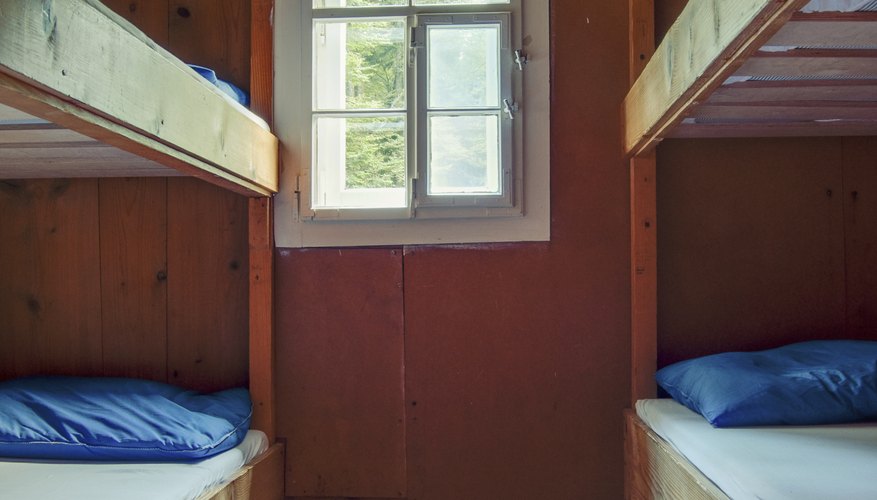Bunk beds are a great way to save space in a bedroom, and kids really like them. Most bunk beds use twin-size mattresses, which measure 99 x 190 cm (39 x 75 inches). You can build two separate twin beds and stack them, or you can build the two beds as a single unit.
Considerations
You can stack separate beds by building two headboards and two footboards that are interchangeable. Center and drill 1.2 cm (1/2 inch) holes in the tops of the headboard corner posts, then centre and drill 1.2 cm (1/2 inch) holes in the bottoms of the footboard corner posts. Put the two headboards on the lower bunk and the two headboards on the top bunk, then insert 1.2 cm (1/2 inch) diameter dowels into the holes to hold the beds together.
- You can stack separate beds by building two headboards and two footboards that are interchangeable.
- Put the two headboards on the lower bunk and the two headboards on the top bunk, then insert 1.2 cm (1/2 inch) diameter dowels into the holes to hold the beds together.
Whether you build separate beds or a single unit, you need to leave at least 60 cm (2 feet) of headspace between the bunks, and as much between the top bunk and the ceiling. Placing the mattresses on platforms will leave you more room than a mattress/box spring combination.
Construction
Do not skimp on the corner posts. Use wood that is at least 10 cm x 10 cm (4 x 4 inches) or 5 cm x 15 cm (2 x 6 inches), to ensure adequate strength. The rails (sometimes called "boxes") that frame the mattress need to be 2.5 to 5 cm (1 to 2 inches) wider and longer than the mattresses so you have room for the bedding. You can add ridges to the insides of the side rails to support the slats or platforms that the mattresses will lie on; for example, you might glue and nail 5 x 5 cm (2 x 2 inch) boards to the inside of 5 cm x 15 cm (2 x 6 inch) side rails. This gives you a very sturdy support for the mattress. Or you can screw through the two side rails and into the ends of some 5 cm x 10 cm (2 x 4 inch) boards. These will take the place of both the ridges and slats.
- Do not skimp on the corner posts.
- The rails (sometimes called "boxes") that frame the mattress need to be 2.5 to 5 cm (1 to 2 inches) wider and longer than the mattresses so you have room for the bedding.
If you are using box springs, you will only need four or five slats to support it and the mattress; if you use slats only, you should use enough of them to make a solid "floor" for the mattress. If you choose to make a platform bed, you can use a piece of 1.8 cm (3/4 inch) plywood large enough to fill the frame.
Crash barriers and ladders
Although some bunk bed plans do not include them, you need to build crash barriers along the sides of the top bunk. They need to extend at least 15 cm (6 inches) above the top of the mattress to be effective. Likewise, the person sleeping in the top bunk needs a sturdy ladder for access. This ladder must be strong enough to hold the weight of the person climbing it, and it must be secured to the bunk so it won't fall off. Use metal angle mounts that can be hooked over the side rail.
- Although some bunk bed plans do not include them, you need to build crash barriers along the sides of the top bunk.
- This ladder must be strong enough to hold the weight of the person climbing it, and it must be secured to the bunk so it won't fall off.
